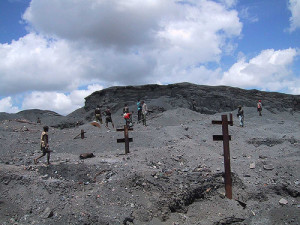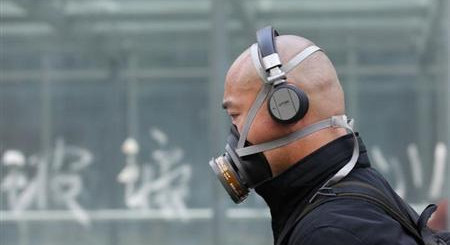World’s Top 10 Most Polluted Places
Blacksmith Institute and Green Cross Switzerland have released the 2013 report of the world’s polluted places: the result of 2,000 risk assessments at contaminated sites in 49 countries. The horrible top ten list covers a wide range of polluted places: from industrial plants and mining facilities, through industrial estates and SME clusters, to areas of polluted air and water, and some major industrial disasters.
The criteria used to evaluate the sites included the size of the population affected, the potency of the toxicants involved and clearly established pathways and impacts. Richard Fuller, founder and president of the nonprofit Blacksmith Institute, believes that pollution is still one of the most serious problems the earth faces and he believes that the best approach to solving these problems and save lives at risk is a strong determination. “The problem is really much larger than these 10 sites”.
- Agbogbloshie Dumpsite, Accra, Ghana
Everybody wants a laptop these days and Agbogbloshie Dumpsite, ranked first, is the second largest e-waste processing area in West Africa.
The volume of imports is around 215,000 tons of secondhand consumer electronics from abroad, primarily from Western Europe and with 129,000 tons of e-waste every year with many ecological problems for the high lead levels in soil and 40,000 people at risk because of the metals that migrate through particulate in the smoke and in the air.
- Chernobyl, Ukraine
Chernobyl, one of the worst catastrophic nuclear disasters in history and classified as a level 7 event (the maximum classification) on the International Nuclear Event Scale.
150,000 square kilometers of land was affected in the accident. To this day 19-mile exclusion zone entirely uninhabited, over a dozen artificial radionuclides such as cesium-137 that can be detected in the surface soil around the plant. 400 million people resided in territories that were contaminated with radiation at a level higher than 4 kBq/m2 there has been a significant increase in the risk of leukemia and 4,000 cases of thyroid cancer.
- Citarum, Indonesia
Citarum River Basin is one of the strategic Basins in West Java. Around 30 million people rely on this water basin whoprovides as much as 80% of surface water to Jakarta’s water supply authority. The population is affected by a range of contaminants from both industrial and domestic sources present in the river: aluminum, manganese (nearly four times those recommended levels), and iron concentrations in the river were 97 ppb, 195 ppb, and 194 ppb.
- Dzerzhinsk, Russia
One of Russia’s most significant center of the chemical industry, Dzershinsk in 2007, was the most polluted city in the world, with levels of dioxins and phenol thousands of times above recommended levels. Over the last several years, efforts have been undertaken to remediate contaminated land even though the toxic emissions and pollutants from local industries are affecting all of the local residents suffering from increased levels of diseases and cancers of the eyes, lungs, and kidneys.
- Hazaribagh, Dhaka, Bangladesh
270 registered tanneries in Bangladesh and around 90 percent are located in Hazaribagh. Every day, the tanneries collectively dump 22,000 cubic liters of toxic waste, including cancer-causing hexavalent chromium, a well-known carcinogen, into the Buriganga, Dhaka’s main river and a key water supply. Workers and local residents face a number of less severe yet more common health problems every day.
- Kabwe, Zambia
As the result of contamination from lead mining in the area, which is situated around the Copperbel, children’s blood lead levels in Kabwe exceeded the recommended levels by five to ten times and can potentially be fatal.
- Kalimatan, Indonesia
More than 1,000 tons of mercury are released into the environment each year from Artisanal and small scale gold mining (ASGM) and constitutes about 30 percent of the anthropogenic mercury emissions. One article published in the Journal of Water and Environment Technology in 2008 found a concentration of mercury, in the Kahayan River of Central Kalimantan was 2,260 ng/L. This is more than twice Indonesia’s standard for total mercury (which is poisonous) in drinking water (1,000 ng/L).
- Rio Matanza, Argentina
15,000 industries are actively releasing effluent into the Matanza-Riachuelo River Basin and the soil on the banks of the river contained levels of zinc, lead, copper, nickel, and total chromium that were all above recommended levels. Associated with the industries in the basin significant public health problems such as diarrheal diseases, respiratory diseases, and cancer.
- Niger River Delta, Nigeria
This site, heavily polluted by oil and hydrocarbons, has been has been the site of major petroleum operations since the late 1950s. In 2012 320,000 m3 (2 million barrels) of oil were being extracted from the delta every day and an average of 240,000 barrels. In the process groundwater and soil have been heavily polluted, devastating aquatic and agricultural communities.
- Norilsk, Russia
Norilsk, Russia, industrial city founded in 1935. Life expectancy for factory workers affected by pollution: 10 years below the Russian average. Over 130,000 local residents are being exposed to particulates, sulfur dioxide, heavy metals, and phenols each day from air pollution and children are especially vulnerable.






